The Canon Rangefinder Camera of 1950
A limited producion of a Canon model of 1950
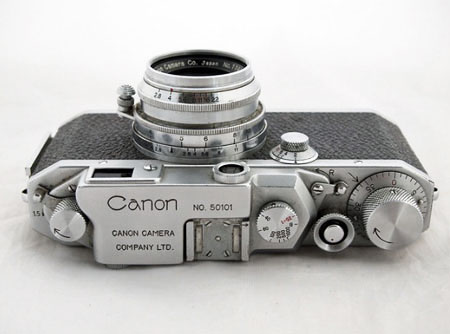
Canon of 1950
Introduction a New Camera in 1950
In 1950, Canon introduced a single new camera model with an improved shutter and flashbulb synchronization. Peter Dechert in his definitive book "Canon Rangefinder Cameras 1933-1968" has given this camera the name "Canon 1950", since it was the only Canon camera introduced in 1950. This name is now universally used for this unique camera. These cameras had serial numbers in the range 50000-50200.
Canon 1950
Only about 50 of these Canon 1950 cameras were produced. 1 Most were sold by C. R. Skinner Company, 292-294 Turk Street, San Francisco, managed by Clifton Ross Skinner. The Skinner-sold cameras had "Serviced and Guaranteed in San Francisco California" on their base.

Peter Dechert wrote that perhaps another 150 units of this camera were sold via other outlets, and without the "Serviced and Guaranteed in San Francisco California" engraving on the base. 20
This 1950 camera model had a number of important innovations:
- a new shutter with speeds to 1/1000 second in two shutter dials, split at 1/25 second, rather than the previous 1/20 second.
- addition of a T time exposure to the slow speed dial
- and improved rangefinder
- a new rewind mechanism, with an A-R (advance-rewind) lever added to a raised step located next to the fast shutter speed dial on the camera cover.

- particularly important, the new shutter was synchronized for flashbulbs.
Peter Dechert also wrote:
Most, if not all, of the concepts first reflected in these new 200 or fewer cameras originated with Hiroshi Suzukawa, a talented designer who had joined Canon in 1948. The trial cameras all incorporated a completely new shutter design: the highest speed was increased to 1/1000 sec, and the speeds on the fast and slow dials were now split at 1/25 instead of 1/20. A "T," for "Time," setting was included on the slow speed dial; when engaged, it locked the shutter open until the slow dial was moved to another setting. The "B" setting remained on the fast speed dial. The shutter guard ring was also redesigned to be wider and allow the use of a cable release without first having to remove the ring.

Canon 1950 serial number 50057
Flash Synchronization
The synchronization connection of the Canon 1950 was made by a vertical bar attached to the camera side into which could be slid a Canon flash unit. This connection was unique to Canon, and continued to be used on synchronized Canons for the next 5 years.
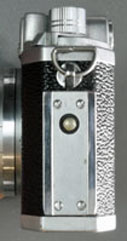
Synchronization was for flash bulbs; not for the later developed electronic flash. Canon also developed several versons of a flash gun which would slide into this flash bar.
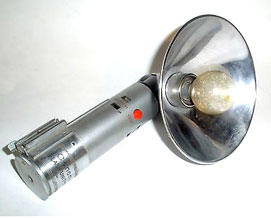
The Canon 1950 was produced with the older Canon IIB type camera shell rather than a new black body shell of the Canon IV which was introduced during the next year: 1951. The top plate of the Canon 1950 is labelled "Canon Camera Company Ltd." Beginning 1951, Canon cameras were labelled "Canon Camera Company Inc."
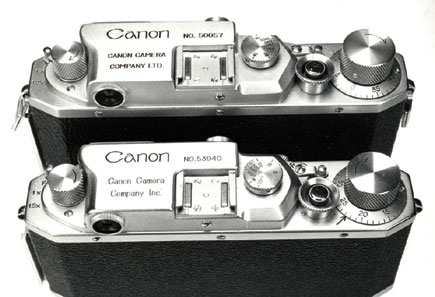
Canon 1950 top and Canon IV bottom with new company name
Click on the link below to read about the Canon IV introduced in 1951.
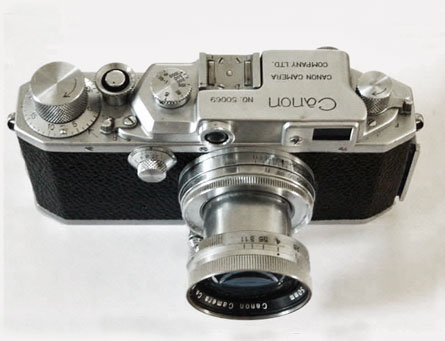
Canon 1950 serial number 50069 and serial number 50160
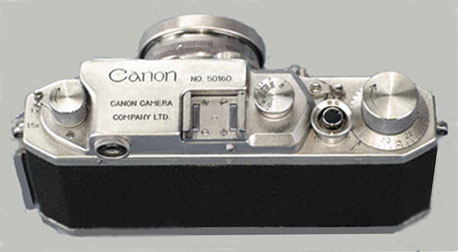
| Navigation: Click Below to Jump to Desired Subject Page | ||
|---|---|---|
| Canon Rangefinder Cameras - 1 | Canon Rangefinder Cameras - 2 | Canon Rangefinder Lenses |
| Canon S | Canon IVSB2 | Canon 19mm |
| Canon J | Canon IIS2, IID2, IIF2 | Canon 25mm |
| Canon NS | Canon VT, Canon L2 | Canon 28mm |
| Canon JS | Canon L1, L3 | Canon 35mm |
| Canon J-II | Canon VT Deluxe | Nikkor 50mm |
| Canon S-II | Canon VL, VL2 | Canon 50mm |
| Canon IIB | Canon VI-L, VI-T | Canon 85mm |
| Canon III, IIC, IV | Canon P | Canon 100mm |
| Canon IIIA, IVF, IVS | Canon 7 | Canon 135mm |
| Canon IIA, IID, IID1 | Canon 7s | Canon 200mm-1000mm |
| Canon IVSB | Minolta Rangefinders | Minolta Lenses |
| Canon IIF, IIS | Other Rangefinders | other M39 lenses |
| Go to canonrangefinder.com home page | ||
Any additions or corrections to these pages would be welcome simply by contacting this site as shown at the foot of this page .
Footnotes:
1 Dechert, Peter. Canon Rangefinder Cameras 1933-1968. Hove Collectors Books. West Sussex, United Kingdom. 1985. ISBN 0-906447-30-5.
Peter Dechert's book is the most important expert source of information regarding Canon Rangefinder Cameras.
2 Kitchingman, Peter. Canon M39 Rangefinder Lenses 1939-1971. A Collector's Guide. Published by Peter Kitchingman. Perth, Australia. 2008. ISBN 978-0-646-48144-9.
Peter Kitchingman's book is the definitive study of the more than three decades of M39 format camera lenses developed for Canon Rangefinder Cameras.
3 Nostalgic Canon Camera Book. 懐かしいキヤノン EI Publishing Co. Ltd. Tokyo, Japan. June 2003.
Peter Kitchingman's book is the definitive study of the more than three decades of M39 format camera lenses developed for Canon Rangefinder Cameras.
4 "Canon Camera Museum" history website. https://global.canon/en/c-museum/history/ published by Canon, Inc. accessed in 2019.
5 Rajner, Hans P. (author), John Wade (editor). Leica Copies. Classic Collections Publications. London, UK. ISBN 13: 9781874485056
Hans P. Rajner's book is an excellently detailed and carefully researched study of camera from around the world which used the Leica M39 lens mount and the same lens to film plane distance.
7 Dechert, Peter. Canon Single Lens Reflex Cameras 1959-1991. Historical Camera Publications. Yakima, Washington. 1992. ISBN 1-879561-04-2.
8 Tomlinson, Shawn M. The Film Photography Book. Lulu Pulbications. 2016. ISBN: 9781365263972
9 Sartorius., Ghester. Identifying Leica Lenses. Classic Camera 19. Tokyo, Japan. 2001. ISBN 4-257-12029-0
10 website http://www.nicovandijk.net/rflensmatrix.htm consulted 2019.
11 O'Reagan, Douglas M. Allied Exploitation of German Science after World War II. Johns Hopkins University Press. Baltimore, Maryland. 2019. ISBN 9781421428888
12 website www.canonrangefinder.servehttp.com consulted 2008.
13 Minolta expert Andrea Aprà has posted information on minoltarangefinders group and other groups and further detailed information by email. (thanks Andrea !)
14 website http://www.collection-appareils.fr/objectifs/ consulted 2019.
15 Small, Marc James. Non-Leitz Leica Thread-Mount Lenses. Wittig Books. Hückelhoven, Germany. 1997. ISBN 3-930359-47-2.
16 the Nikon Corporation website: https://imaging.nikon.com/history/ consulted 2019.
17 p 152. Ray, Sidney F. Photographic Lens ISBN 9780240510323
18 website http://www.rokkorfiles.com/Lens%20History.html accessed 2019
19 p. 10. Dechert, Peter. The Contax Connection. The History of the Japanese Camers. Historical Camera Publications. 1 August 1990.
24 Dechert, Peter. https://www.rangefinderforum.com/forums/showthread.php?t=47703 accessed 2020.
If you have any comments or questions about this Canon Rangefinder site, please e-mail me (Larry Huffman) at e-mail address: [email protected]